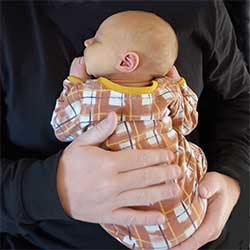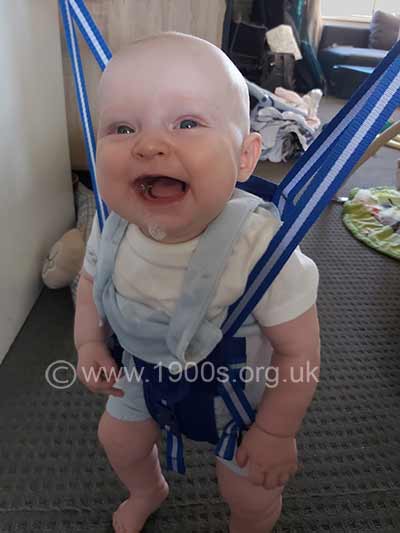How antenatal care changed in Britain over the years

Antenatal care is the care that pregnant women receive leading up to the birth of their babies. This page starts with a description of it during the 1960s in the UK when it was very different than it is today. A feature, compared to today was that there was no pregnancy test which meant that confirmation of pregnancy had to be based on symptoms and appearance. The page describes what was involved in getting into that antenatal system and what it was like to experience it, based on the direct recollections of the webmaster and her contemporaries. Finally, developments in antenatal care over recent years are considered along with areas for improvement.
____
By the webmaster based on firsthand recollections and additional research
No pregnancy test in the past: the slow dawning of being pregnant
The understanding that a pregnancy was real dawned slowly in years gone by.
There was no pregnancy test in the 1950s - at least not in the NHS and not for ordinary women. If a period was missed, a woman wondered, and if a second period was missed, she went to her local GP to get into the antenatal system.
Getting into the antenatal system
The visit to the GP
The local GP - who always seemed to be a male doctor - didn't normally give any sort of examination.
For me, when I told my doctor that I had missed two periods, he certainly didn't examine me. He just made an appointment for me to attend the local hospital to get myself registered as an expectant mother. I was told, though, of one doctor who did give a likely pregnancy confirmation by feeling externally for some small difference in women's stomach - but it was not guaranteed.
Registration at a hospital
There was no choice of NHS hospital, only the local one. It didn't examine me either. The staff there just worked on the assumption that because a woman was there, she must be pregnant. They just got her into the system by filling in appropriate forms. After all, she could easily be removed later if she turned out not to be pregnant. The 'system' involved taking blood pressure and giving out nutritional advice. I can't remember if there was a blood test, but I don't think so. The woman was also allocated a pre-natal clinic which would monitor progress and run antenatal classes. I seem to remember that iron pills were prescribed.
So you can see how it was that the understanding that a pregnancy was real really did dawn slowly.
The signs of being pregnant: symptoms and appearance
Still no examination.
Morning sickness was the next real sign of being pregnant. Not that it was necessarily in the morning and it could have been an aversion to particular foods rather than actual sickness. I went off coffee; other women went off tea and others fancied large quantities of unusual foods.
Soon of course an expanding stomach gave the final confirmation, and women threw themselves into preparation for having a baby.
Tests and examinations
I suppose at some stage I must have had some sort of examination, but I don't remember one. Neither do I remember any blood or urine tests. Certainly there were no scans.
Antenatal classes
I dutifully went along to antenatal classes.
In general, the talks told me what I am sure was no more than most of us already knew, and they were extremely patronising. For example, various foodstuffs were discussed while felt pictures of them were stuck onto a felt display board. I do of course appreciate that the talks must have been better in some areas than in others.
Training for pain free childbirth
There was a great emphasis on pain relief due to what was called 'natural childbirth' which was a form of relaxation and breath control supposed to counter the pain of childbirth. A lot of time was spent in the classes practising it. I believed in it totally, probably because, as a young woman, I had never experienced real pain and I was confident that so many experts couldn't be wrong in propounding it. I practised it daily at home.
In the event, for me at least, I felt that it had been a huge con, as I had never before experienced so much pain. Presumably some women benefited, and pain free birth is by no means unknown.
Was it worth it?

Of course it was worth it!
Improvements in antenatal care over recent years
Antenatal care in the UK has improved a great deal over the years, thanks to advances in medical knowledge, technology, research, education, and policy.
Policy changes relating to antenatal care and childbirth
Bing Chat has come up with the following policy changes since the middle of the last century that relate to antenatal care. The first was before I had my own children and was already an assumed benefit, but it is included here for completeness.
• The foundation of the NHS in 1948 marked a turning point in the history of maternity services and sparked renewed interest in maternal health. Women and children were perhaps its greatest beneficiaries, having gained least from the pre-war health insurance schemes.
• The Peel Report of 1970 recommended that all women should give birth in hospital, as this was seen as safer and more efficient than home births. This led to a dramatic decline in home births, from about one-third of all births in the late 1940s to less than five percent by 1975.
• The Changing Childbirth Report of 1993 advocated for more choice, continuity, and control for women in their maternity care. It emphasised the importance of woman-centred care, informed consent, and respect for individual preferences.
• The National Service Framework for Children, Young People and Maternity Services of 2004 set out standards and guidelines for improving the quality and safety of maternity care. It promoted the involvement of fathers and partners, the provision of antenatal classes and peer support, and the reduction of inequalities in access and outcomes.
• The Maternity Matters Report of 2007 outlined four key choices for women: where to access antenatal care, where to give birth, who to have as their lead professional, and what kind of postnatal support to receive. It also aimed to improve the availability and quality of midwifery-led care, home births, and birth centres.
• The Better Births Report of 2016 proposed a vision for transforming maternity services in England by 2021. It called for more personalised care, more continuity of carer, more collaboration across professions and organisations, more community-based services, and more digital innovation.
I never cease to be amazed at what appears today to be normal practice for my granddaughters' antenatal care. Women now have more access to information on the internet, regular screening tests, specialist services, and personalised care plans; they have more options for where and how to give birth, and they are encouraged to be involved in decision-making. Perhaps most important of all, apart from giving birth to a healthy baby, is the understanding and expectation that they will be free of pain due to epidural anaesthesia.
There are of course still challenges and inequalities in provision in the UK, particularly due to staff shortages, funding cuts, regional variations, and the diverse needs of different groups of women.
| sources | webmaster | contact |
Text and images are copyright
If you can add anything to this page or provide a photo, please contact me.



